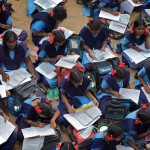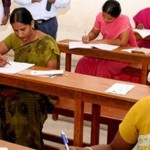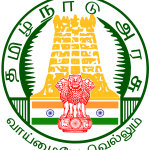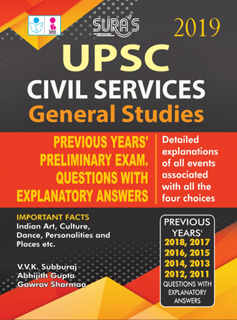
1. Upanishads are the books on
A) religion B) philosophy
C) yoga D) law
Explanation : Ans : (B)
The Upanishads, a part of the Vedas, are ancient Sanskrit texts that contain some of the central philosophical concepts and ideas of Hinduism, some of which are shared with religious traditions like Buddhism and Jainism. The Upanishads played an important role in the development of spiritual ideas in ancient India, marking a transition from vedic ritualism to new ideas and institutions. Of all Vedic literature, the Upanishads alone are widely known, and their central ideas are at the spiritual core of the Hindus.
2. V.D. Savarkar organized the ‘secret society’ namely
A) London society
B) Anusilan Samiti
C) Abhinav Bharat
D) Jugantar
Explanation : Ans : (C)
London Society (1912) :
The London Society is a British membership organisation established to encourage Public interest and participation in urban planning and transport matters in London as well as to study and celebrate the capital’s unique history and character. It is among the oldest civic societies in the United Kingdom. It was founded in 1912.
Anushilan Samiti :
The Anushilan Samiti was established by Pramathanath Mitra, a barrister from Calcutta. The people associated with this Samiti were Sri Aurobindo, Deshabandhu Chittaranjan Das, Surendranath Tagore, Jatindranath Banerjee, Bagha Jatin, Bhupendra Natha Datta, Barindra Ghosh etc.,
Out of them Bhupendra Nath Datta was brother of Swami Vivekananda. Barindra Ghosh was sent to Paris to learn the science of Bomb making and here he came in touch were Madam Kama. Madam Kama was already associated with the India House and the Paris India Society.
Abhinav Bharat :
Abhinav Bharat Society was launched in 1904 by V D Savarkar. One member of this organization Anant Lakshaman Karkare shot dead the district magistrate at Nasik. On 21st of December, 1909, AMT Jackson the magistrate at Nasik was enjoying a theater where a drama was staged in his honor on the eve of his transfer. Ananat Laxman Karkare shot this indologist and “Pandit” Jakson dead, in the theatre. This sensational murder is known as Nasik Conspiracy Case. 27 members of the Abhinav Bharat Society were convicted and punished. Ganesh Savarkar, brother of VD Savarkar was sent to Kala Pani.
3. Which of the following committee is associated with central vigilance commission ?
A) Sarkaria Committee
B) Mandal Committee
C) K. Santhanam Committee
D) S.K. Dhar Committee
Explanation : Ans : (C)
The Central Vigilance Commission (CVC) is the main agency for Preventing Corruption in the Central government. It was established in 1964 by an executive resolution of the Central government. Its establishment was recommended by the Santhanam Committee on Prevention of Corruption (1962 – 64).
Thus, originally the CVC was neither a constitutional body nor a statutory body. In 2003, the Parliament enacted a law Conferring statutory status on the CVC.
Composition :
The CVC is a multi-member body consisting of a Central Vigilance Commissioner (Chairperson) and not more than two vigilance commissioners. They are appointed by the President by warrant under his hand and seal on the recommendation of a three-member committee consisting of the Prime Minister as its head, the Union Minister of Home Affairs, and the Leader of Opposition in the Lok Sabha.
They hold office for a term of four years or until they attain the age of sixty five years, whichever is earlier. After their tenure, they are not eligible for further employment under the Central or a State government.
4. The president of International Bank for Reconstruction and Development (IBRD) is
A) Mariya Gabriel B) Banki Moon
C) Boyko Borissov D) Jim Yong Kim
Explanation : Ans : (D)
The International Bank for Reconstruction and Development (IBRD) is an international financial institution that offers loans to middle-income developing countries. The IBRD is the first of five member institutions that compose the World Bank Group and is headquartered in Washington. D.C., United States. It was established in 1944 with the mission of financing the reconstruction of European nations devastated by World War II.
The IBRD and its concessional lending arm, the International Development Association (IDA), are collectively known as the World Bank. Following the reconstruction of Europe, the Bank’s mandate expanded to advancing worldwide economic development and eradicating poverty.
The IBRD provides commercial-grade or concessional financing to sovereign states to fund projects that seek to improve transportation and infrastructure, education, domestic policy, environmental consciousness, energy investments, healthcare access to food and portable water, and access to improved sanitation.
Purposes :
The goal of the World Bank is to promote economic development that benefits poor people in developing countries. Loans are provided to developing countries to help reduce poverty and to finance investments that contribute to economic growth. Investments include roads, power plants, schools, and irrigation networks, as well as activities like agricultural extension services, training for teachers, and nutrition – improvement programs for children and pregnant women. The World Bank also provides technical assistance to help governments make specific sectors of their economies more efficient and more relevant to national development goals
5. Which one of the following statement is not correct ?
I. Rajasthan is the largest state of India in area
II. Madhya Pradesh is the second largest state in India in area
III. Maharashtra is the third largest state in India in area
IV. Karnataka is the fourth largest state in India in area
Select the correct answer :
A) I B) II
C) III D) IV
Explanation : Ans : (D)
Rajasthan is the largest state in India. It covers an area of (342,239 square kilometres). This represents 10.4% of the whole India.
Madhya Pradesh is the second largest state in India. It covers an area of (3,08,245 square kilometres).
Maharashtra is the third largest state in India. It covers an area of (3,07,713 square kilometres).
Uttar Pradesh is the fourth largest state in India. It covers an area of (2,40,928 square kilometres) not Karnataka.
Karnataka is the sixth largest state in India. It covers an area of (1,91,791) square kilometres.
Tamil Nadu is the eleventh largest state of India. It covers an area of (1,30,058 square kilometres)






